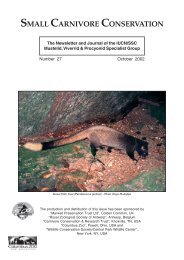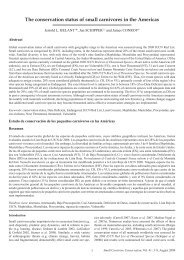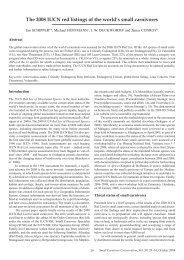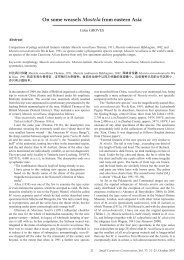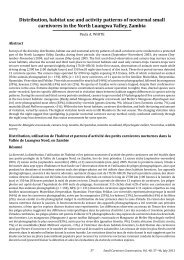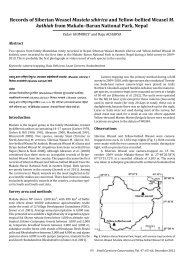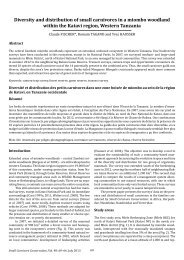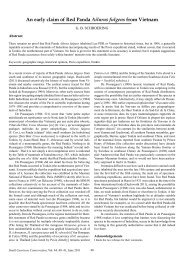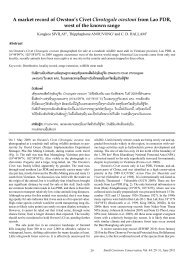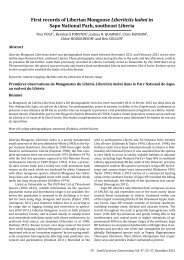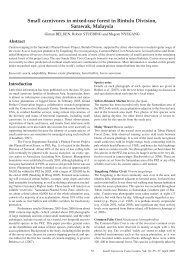Status and ecology of Large-spotted Civet Viverra megaspila in ...
Status and ecology of Large-spotted Civet Viverra megaspila in ...
Status and ecology of Large-spotted Civet Viverra megaspila in ...
Create successful ePaper yourself
Turn your PDF publications into a flip-book with our unique Google optimized e-Paper software.
Gray et al.Fig. 2. Camera-trap encounter rates (number <strong>of</strong> <strong>in</strong>dependentphotographs per 100 camera-trap-nights; ± SEM, us<strong>in</strong>g percameraencounter rate as the sample statistic) <strong>of</strong> <strong>Large</strong>-<strong>spotted</strong><strong>Viverra</strong> <strong>megaspila</strong> <strong>and</strong> <strong>Large</strong> Indian <strong>Civet</strong>s V. zibetha fromcamera-traps located <strong>in</strong> deciduous dipterocarp forest, mosaic <strong>and</strong>mixed deciduous / semi-evergreen forest <strong>in</strong> Mondulkiri ProtectedForest (MPF) <strong>and</strong> Phnom Prich Wildlife Sanctuary (PPWS),eastern Cambodia.Fig. 3. Activity patterns (percentage <strong>of</strong> encounters per hour) <strong>of</strong><strong>Large</strong>-<strong>spotted</strong> <strong>Viverra</strong> <strong>megaspila</strong> <strong>and</strong> <strong>Large</strong> Indian <strong>Civet</strong>s V.zibetha from camera-trap data from Mondulkiri Protected Forest<strong>and</strong> Phnom Prich Wildlife Sanctuary, eastern Cambodia.were, on average, lower than locations support<strong>in</strong>g <strong>Large</strong> Indian<strong>Civet</strong> (Table 1). As expected, both species were strongly nocturnal,with peaks <strong>of</strong> activity <strong>in</strong> the early morn<strong>in</strong>g (02h00–05h00;Fig. 3). <strong>Large</strong> Indian <strong>Civet</strong> was, however, also photographed ontwo occasions dur<strong>in</strong>g the day.DiscussionWe present the first published records <strong>of</strong> <strong>Large</strong>-<strong>spotted</strong> <strong>Civet</strong> fromMondulkiri Protected Forest <strong>and</strong> Phnom Prich Wildlife Sanctuary,eastern Cambodia. We also provide the first evidence <strong>of</strong> microscalesympatry between <strong>Large</strong>-<strong>spotted</strong> <strong>and</strong> <strong>Large</strong> Indian <strong>Civet</strong>s,with both species recorded from the same camera-trap locations(c.f. Duckworth 1994, Aust<strong>in</strong> 1999, Jenks et al. 2010). In MPF<strong>Large</strong>-<strong>spotted</strong> <strong>Civet</strong> was the most frequently recorded small carnivore,occurr<strong>in</strong>g widely <strong>and</strong> appear<strong>in</strong>g particularly common with<strong>in</strong>the flatl<strong>and</strong> deciduous dipterocarp forest, which is the dom<strong>in</strong>anthabitat <strong>in</strong> the protected area. The use <strong>of</strong> open deciduous dipterocarpforest has been previously noted for <strong>Large</strong>-<strong>spotted</strong> <strong>Civet</strong><strong>in</strong> southern Laos (Duckworth 1994, Aust<strong>in</strong> 1999) <strong>and</strong> south-westCambodia (Holden & Neang 2009) <strong>and</strong> we suggest this may bethe preferred habitat for this species. Although previous studieshave suggested some association with water (e.g. Holden & Neang2009, Jenks et al. 2010) we found limited evidence for this.However, two <strong>of</strong> the ten cameras with highest encounter rates(>3 photographs per 100 camera-trap-nights) were located on theedges <strong>of</strong> seasonal waterholes (trapeang) <strong>in</strong> deciduous dipterocarpforest.The Eastern Pla<strong>in</strong>s L<strong>and</strong>scape is amongst the largest, mostremote <strong>and</strong> least disturbed areas <strong>of</strong> lowl<strong>and</strong> forest <strong>in</strong> Indoch<strong>in</strong>a. Inaddition to its presence <strong>in</strong> Mondulkiri Protected Forest <strong>and</strong> PhnomPrich Wildlife Sanctuary, <strong>Large</strong>-<strong>spotted</strong> <strong>Civet</strong> has been recordedfrom Seima Protection Forest (Walston et al. 2001, Schank et al.2009) <strong>and</strong> Yok Don National Park, Vietnam (one camera-traprecord <strong>in</strong> March 2003; Eames et al. 2004). Given the extent <strong>of</strong>suitable flatl<strong>and</strong> deciduous dipterocarp forest habitat with<strong>in</strong> MPF<strong>and</strong> the adjacent ecologically similar Lumphat Wildlife Sanctuary<strong>and</strong> O’Yadao Protected Forest we suggest the Eastern Pla<strong>in</strong>sL<strong>and</strong>scape may be the global stronghold for the species.There is, however, some evidence that <strong>Large</strong>-<strong>spotted</strong> <strong>Civet</strong>may be tolerant, at least to some extent, <strong>of</strong> degraded lowl<strong>and</strong>forest (Aust<strong>in</strong> 1999, Jenks et al. 2010). Degraded <strong>and</strong> disturbedlowl<strong>and</strong> deciduous forest is widespread across the northern <strong>and</strong>eastern Cambodian prov<strong>in</strong>ces <strong>of</strong> Oddar Meanchey, Preah Vihear,Rattanakiri, Stung Treng, Kratie <strong>and</strong> Kompong Thom. Whether<strong>Large</strong>-<strong>spotted</strong> <strong>Civet</strong> persists <strong>in</strong> such l<strong>and</strong>scapes, <strong>in</strong> which medium–largeterrestrial mammals are heavily hunted, is unclear.However, given ambiguous identification <strong>of</strong> foot-pr<strong>in</strong>ts, <strong>and</strong> <strong>in</strong>evitablecamera-trap loss from such areas with relatively high levels<strong>of</strong> human activity, clarify<strong>in</strong>g the extent to which <strong>Large</strong>-<strong>spotted</strong><strong>Civet</strong> occupies degraded lowl<strong>and</strong> forest away from the protectedarea network <strong>in</strong> Cambodia will be difficult. In addition, lowl<strong>and</strong>forest <strong>in</strong> Cambodia, even with<strong>in</strong> some protected areas, is severelythreatened by clearance for social <strong>and</strong> agricultural concessions(particularly rubber plantations). Therefore long-term persistence<strong>of</strong> <strong>Large</strong>-<strong>spotted</strong> <strong>Civet</strong> across many areas <strong>of</strong> lowl<strong>and</strong> Cambodiais doubtful. Ma<strong>in</strong>ta<strong>in</strong><strong>in</strong>g the <strong>in</strong>tegrity <strong>of</strong> protected areas <strong>in</strong> theEastern Pla<strong>in</strong>s L<strong>and</strong>scape therefore may be close to essential forthe conservation <strong>of</strong> <strong>Large</strong>-<strong>spotted</strong> <strong>Civet</strong> together with a suite <strong>of</strong>marg<strong>in</strong>ally higher-pr<strong>of</strong>ile threatened species that are associatedwith lowl<strong>and</strong> deciduous forest (e.g. Banteng Bos javanicus <strong>and</strong>Green Peafowl Pavo muticus; Goes 2009). Strong protected areamanagement across the Eastern Pla<strong>in</strong>s L<strong>and</strong>scape is required forsafeguard<strong>in</strong>g habitat for <strong>Large</strong>-<strong>spotted</strong> <strong>Civet</strong> which should bepromoted as among the significant globally threatened speciespresent <strong>in</strong> the l<strong>and</strong>scape.AcknowledgementsWe thank the Forestry Adm<strong>in</strong>istration <strong>and</strong> the M<strong>in</strong>istry <strong>of</strong> the Environment<strong>of</strong> the Royal Cambodian Government for support <strong>and</strong> permission to work<strong>in</strong> Mondulkiri Protected Forest <strong>and</strong> Phnom Prich Wildlife Sanctuary. PhanChanna, Prum Sovanna, Kheav Oudom, Ing Seangrithy, Lien Nor, VannSmall Carnivore Conservation, Vol. 43, December 201014
<strong>Large</strong>-<strong>spotted</strong> <strong>Civet</strong> <strong>in</strong> CambodiaSonny, Lien Kha, Men Samorn <strong>and</strong> Sary Tre assisted with camera-trapp<strong>in</strong>g<strong>and</strong> Jeremy Holden provided camera-trap tra<strong>in</strong><strong>in</strong>g. Two anonymous reviewersprovided comments which improved the quality <strong>of</strong> this manuscript.Major fund<strong>in</strong>g for camera-trapp<strong>in</strong>g was provided by WWF-US <strong>and</strong> Humanscale.Jeremy Holden <strong>and</strong> Ed Pollard provided useful references <strong>and</strong><strong>in</strong>formation <strong>and</strong> encouraged the production <strong>of</strong> this manuscript.ReferencesAust<strong>in</strong>, S. C. 1999. Camera-trapp<strong>in</strong>g evidence <strong>of</strong> <strong>Large</strong>-<strong>spotted</strong> <strong>Civet</strong><strong>Viverra</strong> <strong>megaspila</strong> <strong>in</strong> Xe Piane National Biodiversity ConservationArea (NBCA), southern Lao PDR. Natural History Bullet<strong>in</strong> <strong>of</strong> theSiam Society 47: 255–257.Corbet, G. B. & Hill, J. E. 1992. The mammals <strong>of</strong> the Indomalayan region.Natural History Museum publications & Oxford UniversityPress, Oxford, U.K.Duckworth, J. W. 1994. Field observations <strong>of</strong> <strong>Large</strong>-<strong>spotted</strong> <strong>Civet</strong> <strong>Viverra</strong><strong>megaspila</strong> <strong>in</strong> Laos with notes on the identification <strong>of</strong> the species.Small Carnivore Conservation 11: 1–3.Duckworth, J. W., Timm<strong>in</strong>s, R. J., Olsson, A., Roberton, S., Kanchanasaka,B., Than Zaw, Jenn<strong>in</strong>gs, A. & Veron, G. 2008. <strong>Viverra</strong><strong>megaspila</strong>. In: IUCN 2010. IUCN Red List <strong>of</strong> Threatened Species.Version 2010.3. www.iucnredlist.org. Downloaded on17 September 2010.Eames, J. C., Nguyen D. T., Le T. T., Dang N. C., Ngo V. T., Hoang D.D., Thai N. T. & Nguyen T. T. H. 2004. Draft f<strong>in</strong>al biodiversity reportfor Yok Don National Park, Dak Lak prov<strong>in</strong>ce. PARC ProjectVIE/95/G31&031, Government <strong>of</strong> Viet Nam (FPD) / UNOPS /UNDP / Scott Wilson Asia-Pacific Ltd, Hanoi, Vietnam.Goes, F. G. 2009. The status <strong>and</strong> distribution <strong>of</strong> Green Peafowl Pavo muticus<strong>in</strong> Cambodia. Cambodian Journal <strong>of</strong> Natural History ‘2009’: 7–15.Holden, J. & Neang T. 2009. Small carnivore records from the CardamomMounta<strong>in</strong>s, southwestern Cambodia. Small Carnivore Conservation40: 16–21.Jenks, K. E., Wanghongsa, S., Songsasen, N., Leimgruber, P. & Howard,J. 2010. Camera-trap evidence <strong>of</strong> <strong>Large</strong>-<strong>spotted</strong> <strong>Civet</strong> <strong>Viverra</strong><strong>megaspila</strong> <strong>in</strong> Khao Ang Rue Nai Wildlife Sanctuary <strong>and</strong> Khao YaiNational Park, Thail<strong>and</strong>. Small Carnivore Conservation 42: 19–21.[JICA] Japanese International Cooperation Agency 2003. Cambodia reconnaissancesurvey digital data project. Meta database. M<strong>in</strong>istry<strong>of</strong> Public Works <strong>and</strong> Transportation, Phnom Penh, Cambodia.Khounbol<strong>in</strong>e, K. 2005. A <strong>Large</strong>-<strong>spotted</strong> <strong>Civet</strong> <strong>Viverra</strong> <strong>megaspila</strong> recordfrom a mid-altitude plateau, Lao PDR. Small Carnivore Conservation33: 26.Lau, M. W.-N., Fellowes, J. R. & Chan, B. P. L. <strong>in</strong> press. Carnivores(Mammalia: Carnivora) <strong>in</strong> south Ch<strong>in</strong>a: a status review with noteson the commercial trade. Mammal Review.Lynam, A. J., My<strong>in</strong>t Maung, Saw Htoo Tha Po & Duckworth, J. W. 2005.Recent records <strong>of</strong> <strong>Large</strong>-<strong>spotted</strong> <strong>Civet</strong> <strong>Viverra</strong> <strong>megaspila</strong> from Thail<strong>and</strong><strong>and</strong> Myanmar. Small Carnivore Conservation 32: 8–11.Rollet, B. 1962. Inventaire forestier de l’est Mekong. UN/FAO, Rome, Italy.Royan, A. 2010. Significant mammal records from Botum-Sakor NationalPark, southwest Cambodia. Cambodian Journal <strong>of</strong> NaturalHistory ‘2010’: 22–26.Rundel, P. W. 1999. Forest habitats <strong>and</strong> flora <strong>in</strong> Lao PDR, Cambodia <strong>and</strong>Vietnam. WWF Indoch<strong>in</strong>a Programme, Hanoi, Vietnam.Schank, C., Pollard, E. H. B., Sechrest, W., Timm<strong>in</strong>s, R., Holden, J. &Walston, J. 2009. First confirmed records <strong>of</strong> <strong>Large</strong>-toothed FerretBadger Melogale personata <strong>in</strong> Cambodia, with notes on countryrecords <strong>of</strong> Melogale. Small Carnivore Conservation 40: 11–15.Tord<strong>of</strong>f, A. W., Timm<strong>in</strong>s, R. J., Maxwell, A., Huy V., Lic V. & Khou E. A.(eds) 2005. Biological assessment <strong>of</strong> the Lower Mekong Dry ForestsEcoregion. WWF Cambodia, Phnom Penh, Cambodia.Walston, J., Davidson, P. & Men S. 2001. A wildlife survey <strong>of</strong> southernMondulkiri prov<strong>in</strong>ce, Cambodia. Wildlife Conservation SocietyCambodia Program, Phnom Penh, Cambodia.Eastern Pla<strong>in</strong>s L<strong>and</strong>scape Project, WWF Greater MekongCambodia Country Program, Phum Doh Kromom, SenMonorom, Mondulkiri, Cambodia.1Correspond<strong>in</strong>g author email: tomnegray@hotmail.comAppendixSpecies MPF PPWS Total<strong>Large</strong> Indian <strong>Civet</strong> <strong>Viverra</strong> zibetha 45 52 97Common Palm <strong>Civet</strong> Paradoxurus 45 35 80hermaphroditus<strong>Large</strong>-<strong>spotted</strong> <strong>Civet</strong> <strong>Viverra</strong> <strong>megaspila</strong> 48 1 49Small Indian <strong>Civet</strong> Viverricula <strong>in</strong>dica 11 9 20Hog Badger Arctonyx collaris 3 5 8Crab-eat<strong>in</strong>g Herpestes urva 5 1 6MongooseFerret badger Melogale 2 1 3Yellow-throated Martes flavigula 1 1 2MartenSmall AsianMongooseHerpestesjavanicus1 0 1Number <strong>of</strong> <strong>in</strong>dependent encounters <strong>of</strong> all small carnivore species photographed<strong>in</strong> Mondulkiri Protected Forest (MPF) <strong>and</strong> Phnom Prich WildlifeSanctuary (PPWS), eastern Cambodia, December 2008 – June 2010.15Small Carnivore Conservation, Vol. 43, December 2010



